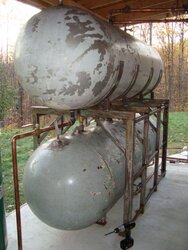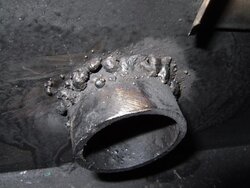Better late than never! Hoprfully someone may still benefit from this reply to your problem. "ARGON' would have been great if you were TIG welding (aluminum), however for mild steel you would need as mentioned in thread (#5)) a 75% Argon, 25% carbon dioxide mix. Gas shield welding. is best suited in a controlled enviroment! (period) The slighest breeze, one you didn`t even feel can effect your effectiveness of the shield. In the field you would need to turn your regulator way up, even then unexperienced welder`s may pull the nozzel unadvertantly to far from the puddle, losing their shield. Flux core wires provide the shield effect, however they contain solid slag`s which once again will have undesired effect if you are not able to stay in the puddle.Maintaining the angle of your wire gun to the puddle, plays a big role in the sucess of either welding procedures. To weld 360 around a small radius such as a threadlette, and maintain your gun angle to the puddle, particularly, in the field can be quite challenging. Set up, and do a dry run to see how far you can controlling the gun and angle,,then weld only that much! Grind the beginning and end of each weld, to a taper, then tie-in and continue again. Strive for at l;east 180, and complete in two passes. Generally speaking, these fitting have generous bevel`s, and once mostly filled in with welds,,,do not require, beveling the cut out hole,,or enlarging the hole,, in order to gain penetration.
Just as noteworthy: Once slag pit`s (porosity) has developed with wire welding, unless experienced with this,,, your Done. Your eyes simply wont see all the porosity in the weld, or that just under the surface which the next weld will penetrate, and bring to the surface. Short of having,,SKD by MAGNAFLUX SPOT CHECK, you wont find it all. This is a 2-part die and developer, Which the water soluable die is sprayed on, then wiped off with water and rag,,next a talcum powder aerosol is applied and quickly dries, leaving a white background and wherever porosity or cracks exist,,there will be a pink spot or line,,,these will then be ground and resprayed untill no more pink exists. It has the ability to detect sub surface inperfections,,the pink just wont be as strong in color.
THE thermal transfer associated with the water and by using the wrong gas,,,resulted in cracks. The fittings held heat longer while the tank and water were extracting heat... with that gas, the weld wont hold up to the thermal stress.
NOT to say,, you cant weld on a supply tank almost full of fluid...Heck you can weld a patch on a DIESAL tank, below the water line, as long as you remove one part of the equation needed for combustion. With the tank mostly full you simply drop "dry ice" into the tank which effectively removes the oxygen, after closing the lid,,weld away..A Marine Chemist would monitor oxygen supply before issuing a permit, and should be contacted to determine the amount of ice needed for a particular size tank.
A 6010 root pass,,6011 filler passes,,and 7018 cap may have served you better, but you still need some experience. Most farm boy`s would have simply used the 6011 only, and had success. The three rods mentioned earlier, would be the process in order to certify for pipe welding.


 !
!
